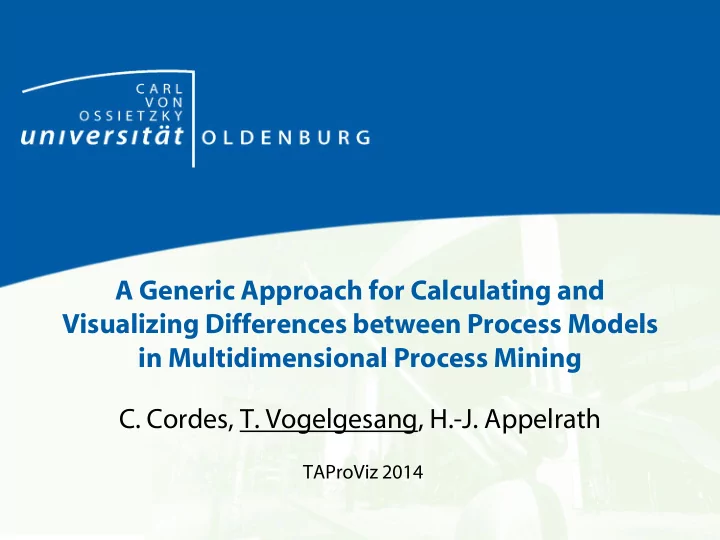

A Generic Approach for Calculating and Visualizing Differences between Process Models in Multidimensional Process Mining C. Cordes, T. Vogelgesang, H.-J. Appelrath TAProViz 2014
Process Mining: An introduction Automatic generation and analysis of process models Based on event logs – Recorded during execution of process – Sequences of events – Process instances – Arbitrary attributes According to: v. d. Aalst et al.: Process Mining Manifesto (2011) 16.09.2014 Thomas Vogelgesang 2
Multidimensional process mining: Motivation Process behavior often influenced by many factors E.g. healthcare processes – Individuality of patients • Age, sex, allergies, … – Individuality of institution • Equipment of hospital, experience of staff, … Process mining typically considers entire event log – One model for all patients – Influence of properties gets blurred 16.09.2014 Thomas Vogelgesang 3
Multidimensional process mining: The idea Define groups of patients with similar properties Separate process mining for each group 16.09.2014 Thomas Vogelgesang 4
Process model differences in MPM: Concept Process mining uses different modeling languages Diff algorithm independent of specific modeling language No restriction to specific diff algorithm Visualization in same modeling language as input Various ways to indicate differences 16.09.2014 Thomas Vogelgesang 5
Intermediate model: TGraphs Intermediate model based on TGraphs [1] – Consists of linked nodes – Nodes and edges are mapped to nodes of TGraph – Annotated with key-value-pairs for additional information [1] J. Ebert and A. Franzke. A Declarative Approach to Graph Based Modeling. In Graphtheoretic Concepts in Computer Science. Springer, 1995. 16.09.2014 Thomas Vogelgesang 6
Difference calculation on intermediate models Arbitrary difference calculation algorithms – Interchangeable through interface Input: TGraph models Output: Tgraph-based difference model – Merged from input models – Nodes marked as added , deleted , changed , unchanged 16.09.2014 Thomas Vogelgesang 7
Difference visualization: View model Same structure as TGraph Consists of different representation nodes – Language-specific – E.g. transitions, places and arcs for Petri nets Representation type defined in language mapping Visualization logic contained in representation nodes – Interchangeable and customizable – Allows visualization of additional information 16.09.2014 Thomas Vogelgesang 8
Differencing multiple models Approach (theoretically) allows to compare an arbitrary number of models – One model needs to be selected as reference model – All differences are related to the reference model In practice only applicable to very few models – Exponential growth of possible diff states of a single node – Experience: not useful for more than three models 16.09.2014 Thomas Vogelgesang 9
Prototype Integrated into tool for MPM (PMCube Explorer) – Based on .NET Different modeling languages – Petri nets, causal nets, Process tree (BPMN-like visualization) [2] Li, Reichert, Wombacher. Representing Block-structured Process Different diff algorithms Models as Order Matrices: Basic Concepts, Formal Properties, Algorithms. Report. (2009) [3] Li, Reichert, Wombacher. On Measuring Process Model Similarity – (Extended) Snapshot diff Based on High-Level Change Operations. In ER'08. (2008). – Block-structured diff [2,3] 16.09.2014 Thomas Vogelgesang 10
Future work Conceptually – User-friendly way to visualize differences for more than two models – Handling of artificial nodes (e.g. silent transitions) in difference calculation Implementation – Improving layout algorithm – Improving maintainability of visualization by using advanced .NET concepts 16.09.2014 Thomas Vogelgesang 11
Conclusions Generic concept for visualizing differences in MPM TGraphs as intermediate model – Supporting arbitrary modeling languages Language-independent difference calculation – Multiple algorithms possible View model with representation nodes – Each node type defines its own visualization – Allows for visualization of additional information Highly customizable – Diff algorithms, layout algorithms, view models 16.09.2014 Thomas Vogelgesang 12
Questions? Thank ank you for your att ttention tion! 16.09.2014 Thomas Vogelgesang 13
Recommend
More recommend